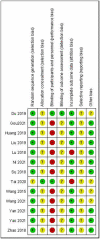Acupuncture as a Complementary Therapy for Cancer-Induced Bone Pain: A Systematic Review and Meta-Analysis
- PMID: 35978992
- PMCID: PMC9377524
- DOI: 10.3389/fpain.2022.925013
Acupuncture as a Complementary Therapy for Cancer-Induced Bone Pain: A Systematic Review and Meta-Analysis
Abstract
Background: Cancer-induced bone pain (CIBP) is a special type of cancer pain and lacks safe and effective treatments. Acupuncture is a potentially valuable treatment for CIBP, studies evaluating the effect of acupuncture on CIBP have increased significantly, but the safety and efficacy of acupuncture to control CIBP remains controversial.
Objective: To provide the first meta-analysis to evaluate the safety and efficacy of acupuncture in CIBP management.
Data sources: CNKI, CBM, Wanfang, VIP Database, PubMed, Embase, and Cochrane Library were searched from their inception until 1 June 2022.
Study selection: RCTs with primary bone tumor patients or other types of primary cancer companied by bone metastases as the research subjects and to evaluate the efficacy of acupuncture treatment alone or combined with the control treatment were included. Meanwhile, RCTs should choose the pain score as the primary outcome and pain relief rate, frequency of breakthrough pain, analgesic onset time, analgesia duration, quality of life, and adverse events as reference outcomes.
Data collection and analysis: We designed a data-extraction form that was used to extract key information from the articles. Data extraction study evaluation was conducted independently by two reviewers, and a third reviewer would resolve any disagreements. The risk of bias was assessed by the Cochrane Collaboration's tool for assessing the risk bias. The quality of the evidence for main outcomes was evaluated by the GRADE system. Mean differences (MD), relative risk (RR), and 95% confidence intervals (CIs) were calculated. The forest plots were performed using the Review Manager Software (5.3 version). Subgroup analysis was used to investigate the possible sources of potential heterogeneity. Descriptive analysis was performed in case of unacceptable clinical heterogeneity.
Results: Thirteen RCTs (with 1,069 patients) were included, and all studies were at high risk of bias owing to lack of blinding or other bias. Eleven studies evaluated the effectiveness of acupuncture as a complementary therapy, and showed that acupuncture plus control treatment (compared with control treatment) was connected with reduced pain intensity (MD = -1.34, 95% CI -1.74 to -0.94; Q < 0.1; I 2 = 98%, P < 0.01). Subgroup analyses based on acupoints type partly explain the potential heterogeneity. The results also showed that acupuncture plus control treatment (compared with control treatment) was connected with relieving pain intensity, increasing the pain relief rate, reducing the frequency of breakthrough pain, shortening analgesic onset time, extending the analgesic duration, and improving the quality of life. We have no sufficient evidence to prove the effectiveness of acupuncture alone. Four RCTs reported only adverse events related to opioids' side effects. Evidence was qualified as "very low" because of low methodological quality, considerable heterogeneity, or a low number of included studies.
Conclusion: Acupuncture has a certain effect as a complementary therapy on pain management of CIBP, which not only mitigates the pain intensity but also improves the quality of life and reduces the incidence of opioids' side effects, although the evidence level was very low. In future, a larger sample size and rigorously designed RCTs are needed to provide sufficient evidence to identify the efficacy and safety of acupuncture as a treatment for CIBP.
Keywords: a systematic review; acupuncture; cancer pain; cancer-induced bone pain; meta-analysis.
Copyright © 2022 Yan, MuRong, Huo, Zhong, Yi, Liu and Liu.
Conflict of interest statement
The authors declare that the research was conducted in the absence of any commercial or financial relationships that could be construed as a potential conflict of interest.
Figures







Similar articles
-
Efficacy and Safety of Acupuncture in Renal Colic Caused by Urinary Calculi in Adults: A Systematic Review and Meta-Analysis.Evid Based Complement Alternat Med. 2022 Jul 4;2022:7140038. doi: 10.1155/2022/7140038. eCollection 2022. Evid Based Complement Alternat Med. 2022. PMID: 35832526 Free PMC article. Review.
-
Acupuncture treatment vs. cognitive rehabilitation for post-stroke cognitive impairment: A systematic review and meta-analysis of randomized controlled trials.Front Neurol. 2023 Feb 9;14:1035125. doi: 10.3389/fneur.2023.1035125. eCollection 2023. Front Neurol. 2023. PMID: 36846126 Free PMC article.
-
Effectiveness and Safety of Acupuncture for Vascular Cognitive Impairment: A Systematic Review and Meta-Analysis.Front Aging Neurosci. 2021 Aug 6;13:692508. doi: 10.3389/fnagi.2021.692508. eCollection 2021. Front Aging Neurosci. 2021. PMID: 34421571 Free PMC article.
-
Clinical Evidence for Association of Acupuncture and Acupressure With Improved Cancer Pain: A Systematic Review and Meta-Analysis.JAMA Oncol. 2020 Feb 1;6(2):271-278. doi: 10.1001/jamaoncol.2019.5233. JAMA Oncol. 2020. PMID: 31855257 Free PMC article.
-
Efficacy and safety of acupuncture for cognitive impairment in Alzheimer's disease: a systematic review and meta-analysis.Front Dement. 2024 Jul 3;3:1380221. doi: 10.3389/frdem.2024.1380221. eCollection 2024. Front Dement. 2024. PMID: 39081600 Free PMC article.
Cited by
-
Metformin relieves bone cancer pain by reducing TGFβRI-TRPV1 signaling in rats.Heliyon. 2024 Jul 20;10(15):e34991. doi: 10.1016/j.heliyon.2024.e34991. eCollection 2024 Aug 15. Heliyon. 2024. PMID: 39157315 Free PMC article.
-
An Overview of Systematic Reviews and Meta-Analyses of Clinical Studies of Acupuncture for Cancer Pain.Integr Cancer Ther. 2023 Jan-Dec;22:15347354231210288. doi: 10.1177/15347354231210288. Integr Cancer Ther. 2023. PMID: 37942632 Free PMC article. Review.
-
Acupuncture in cancer care: recommendations for safe practice (peer-reviewed expert opinion).Support Care Cancer. 2024 Mar 14;32(4):229. doi: 10.1007/s00520-024-08386-6. Support Care Cancer. 2024. PMID: 38483623 Free PMC article. Review.
References
-
- Mao JJ, Liou KT, Baser RE, Bao T, Panageas KS, Romero SAD, et al. . Effectiveness of electroacupuncture or auricular acupuncture vs usual care for chronic musculoskeletal pain among cancer survivors: the peace randomized clinical trial. JAMA Oncol. (2021) 7:720–7. 10.1001/jamaoncol.2021.0310 - DOI - PMC - PubMed
Publication types
LinkOut - more resources
Full Text Sources

